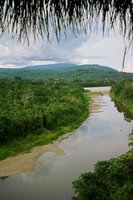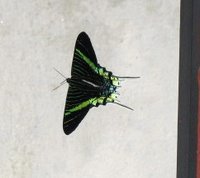Day to Day in Tena
Here is a list of some things I encounter as part of daily life in and around Tena:
Kids on parade

Dogs on rooftops
Vendors on busses selling fruit, shishkabobs, sunglasses, herbal remedies, CDs, razors, wallets, and anything else they can think of
The jungle and swimming in the river

Neighbors sitting outside on their patios chatting, literally, for hours
Fields of laundry

Musical garbage trucks—On garbage day, the trucks drive up and down the streets playing a music-box tune to let people know they should bring their garbage out to the curb. Although the streets are littered, people don’t leave garbage bags out because the trash will rot in the humidity or be torn to bits by stray dogs.
Entrails and meat cuts hanging in open-air butcher shops
Impressive insects—I discovered the black butterfly, with a wingspan the length of my hand, inside the house


Labels: customs, environment, insects



